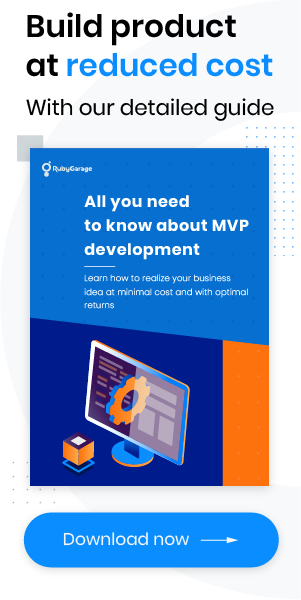-
Product Management
Software Testing
Technology Consulting
-
Multi-Vendor Marketplace
Online StoreCreate an online store with unique design and features at minimal cost using our MarketAge solutionCustom MarketplaceGet a unique, scalable, and cost-effective online marketplace with minimum time to marketTelemedicine SoftwareGet a cost-efficient, HIPAA-compliant telemedicine solution tailored to your facility's requirementsChat AppGet a customizable chat solution to connect users across multiple apps and platformsCustom Booking SystemImprove your business operations and expand to new markets with our appointment booking solutionVideo ConferencingAdjust our video conferencing solution for your business needsFor EnterpriseScale, automate, and improve business processes in your enterprise with our custom software solutionsFor StartupsTurn your startup ideas into viable, value-driven, and commercially successful software solutions -
-
- Case Studies
- Blog
How to Create a Job Board Website Like Glassdoor: Tips, Challenges, Useful Ideas
People will always be looking for jobs. According to a Gallup report, 51 percent of employed people were searching for a new job or watching for openings in 2015. The same research revealed that 58 percent of job seekers look for jobs on online job board websites. The job board market is huge and full of opportunities. Lots of people want a reliable and handy job board website. Why not create one for them?
1. How to create a job board website
There are three options how you can create a job board site:
SaaS solution
Service providers like Strategies, TrueJob, Smartjobboard, and Madgex offer job board platforms and deal with hosting and upgrades. Here are some other benefits (and drawbacks) of SaaS solutions:
Advantages
- Simplicity. You don’t need to think about the technical side of your site, such as hosting, coding, upgrades, and other things that require specific knowledge and skills.
- Price. A SaaS job board isn’t the cheapest option, but it’s cheaper than custom development.
- Support. You’ll have technical support all the time and won’t have to worry about bugs or crashes. Your service provider takes care of everything.
- Analytics. SaaS solutions allow you to track key metrics of your job board website.
Disadvantages
- No customization. You can’t create an absolutely custom design or unique functionality for your product. However, you still can use your company’s colors and logo.
- Lack of control. The software you pay for isn’t yours, and you don’t own or control it. You’re also obliged to use the latest version of the software and can’t avoid upgrades or changes in features.
- Security and data concerns. Access management and the privacy of sensitive information is a major concern with cloud and hosted services.
When to choose a SaaS solution
This is the easiest way to launch your site. If you don’t need it to be unique and want a simple site that really works, then a SaaS platform is for you.
Open source software
Some content management systems like WordPress, Joomla, and Drupal have plugins and themes that allow you to implement a job board platform.
Advantages
- Flexibility. You can customize almost everything in the system, choose the functionality you want, and decide how the site will look.
- Wide range of options. There are a variety of themes and plugins available, but not all of them are free.
Disadvantages
- Technical skills required. You can launch and run a website without much technical knowledge. However, in the event of bugs or crashes, you’ll need a developer’s help.
- You need to choose a domain. And hosting too. You’ll also need to make sure the platform you choose is compatible with your hosting.
- Lack of compatibility. If you already run a website that’s built on another CMS, you can’t build in plugins or themes from WordPress or Joomla.
When to choose open source software
Choose open source software if you want to start fast and validate your business idea with a minimal budget. This option can work perfectly if you already have a site built on a CMS. In that case, you may only need to add a theme or a plugin.
Custom development
Custom development means that you’ll hire a team of developers or a development agency to create your job board website. Here’s what you get when choosing this option:
Advantages
- Unique design. Not only the design but also the user experience (UX) affect how easy it is to apply for a position. A study by CareerBuilder revealed that one in five applicants refuse to fill out an application if it takes them longer than 20 minutes, and 76% of job seekers want to know the approximate time needed to fill out an application. A better UI/UX is your chance to stand out from your competitors.
- Security. You decide how secure you want to go. With a custom website, it’s easier to control the security measures on your site.
- Scalable architecture. If you want to launch fast, you can start with a minimum viable product. An MVP allows you to validate your business idea with little investment and understand what improvements you can make. Custom development allows you to create an MVP with an architecture that’s scalable and reliable for future development.
Disadvantages
- More expensive. This option is more expensive than the previous two and can require more time.
- Requires your participation. While cooperating with a development agency, you’ll need to be involved in the development process and keep in touch with the development team.
When to choose custom development
Custom development is the best option from the long-term perspective. It allows you to build a solid base for your business. A well-thought-out architecture lets you scale your product and add new features when the website grows. And your custom software can be made compatible with other systems and programs you may want to create or already use.
If you prefer this option, let’s find out what functionality your custom job board website should include.
2. Key features of a job board website
Now let's have a look at the necessary features for a job board website. They’re divided into two parts: features for job seekers and features for employers.
Features for job seekers
- Personal profiles. To register, a job seeker needs to enter their name, location, and email and create a password.
- Upload/send a resume. Job seekers should be able to upload a resume and send it with their cover letter.
- Job search. It’s important to add various search filters so users can choose not only a job title and city but also their desired salary, company size, and ability to work remotely, for example.
- Salary comparison. This feature allows job seekers to check salary rates in their country or city for a chosen position.
- Employer profiles and reviews. A job seeker can view an employer’s profile, check out all vacancies, and read reviews about the company. This information is very important for candidates. A CareerBuilder survey from 2016 discovered that 64 percent of candidates read about a company online, and 37 percent said they would consider another job offer if they couldn’t find any information about the company.
- Contact an employer. This feature allows users to easily apply for a job, write an email to an employer, and send a resume.
Features for employers
- Personal profiles. Here employers can tell about their companies, their teams, their spheres of activity, and their company’s values and goals.
- Job postings. This feature allows employers to post their open positions.
- Candidate search. Filters should help employers find the most suitable candidates.
To make your job board website more appealing for job seekers and employers, you can add additional functionality. These features make the search process more interesting, informative, and successful.
Extra features for a job board site
Salary calculator
Along with the minimum, maximum, and average salaries for a particular job, a user can also find out what their personal market value is. This type of calculator requests information about a person’s occupation, educational experience, and current salary. The system then compares the user’s data against current job market information and calculates their market value. You can check out this feature on Glassdoor.com.

Resume writing services/resume builder
Some candidates find it difficult to write about themselves or make a resume. That’s why job search services offer simple questionnaires. The information provided is stored and can be easily sent to employers. Here’s how Indeed.com does it.

You can include the average time needed to fill out this form so candidates are sure that they won’t be filling this form for ages.
Bookmark or hide a job post
If a person likes a job post but is hesitating to apply, they can bookmark it and check it out later. On the other hand, job seekers can hide posts that aren’t interesting. Glassdoor.com has this feature.

Private, limited, or public resumes
Not all job seekers want all employers to see their resumes. That’s why some job board websites have different levels of resume privacy.
For example, Monster.com allows employees to make their resumes public, limited, or private. Public resumes are open so everyone can view them. Limited resumes hide a person’s contact information and current company. Private resumes are unsearchable for employers and can be viewed only if someone applies for a particular job.
3. Challenges you can face building a job board website
Understanding the following difficulties can help you avoid them. Below, we described the most common issues for all job board sites.
#1 Matching algorithm
Candidate mismatch is a real problem in the human resources sphere. The Society for Human Resource Management (SHRM) estimates that the average cost per hire for organizations is more than $4,000. And after that amount is spent, one in three employees quit their jobs after only six months!
The problem is that a candidate who looks like a good match may not have all the necessary skills or may actually be overqualified for the position. It may also happen that a job doesn’t meet a candidate’s expectations.
Mismatching is the result of outdated search algorithms built on SEO principles. The more “right keywords” a candidate uses in their resume, the better the chance they’ll be in the short list of best matches.
Today, job search programs rely more on cutting-edge technologies such as artificial intelligence and machine learning. Systems built on these technologies are more reliable and offer more precise resume matching.
For instance, IBM has launched resume matching software based on artificial intelligence. The system searches for the most qualified candidates and eliminates human bias. How does it work? The program checks not only resumes but also social networking accounts to find more information about a person. Then, it matches that person’s professional and soft skills to find the perfect job.
Woo has launched its own algorithm based on machine learning. Its goal is to calculate what a job seeker wants in a new position and match that with both the required skill set and what an employer can offer. Woo claims that this method is much more efficient because employers only contact candidates who are a great match and will likely accept a job offer.
#2 Reliability of job postings
Users of some large job board sites like Monster.com and Craigslist complain about issues like outdated job posts and too much spam.
The first issue arises when there’s little moderation on a website. To avoid this, think about how you can regulate the quality of job posts on your site. One option is to do it automatically, with an algorithm that checks the date of posting, the person or company that made the posting, and the status of the posting. The problem will solve itself if you charge a fee for job postings.
The issue with spam occurs when companies get easy access to the emails and phone numbers of job seekers. That’s why all private information has to be protected at the highest level. This is the next big issue on our list.
#3 Privacy violations
“Submitting a resume on the internet could result in a privacy nightmare for would-be job seekers. Job seekers’ names, email addresses, and resumes have economic value, and this data often comprises a significant source of profit for job search sites and related businesses” says Pam Dixon, Executive Director at the non-profit research group World Privacy Forum.
Back in 2002, there were cases when databases of resumes were sold by one job search platform to another. Today, residents of European Union countries are protected by GDPR. This law prohibits sharing of personal information without permission of its owner. In the US, a lot of different laws protect personal information of American citizens. However, they work only in particular states (CCPA in California) or only in specific spheres (HIPAA in the medical sphere). Unfortunately, there isn’t a single law in the US that regulates all aspects of private data collection, processing, and storage as GDPR does.
But even with all these laws, your users are still vulnerable. Here are some measures you can take to improve your website security.
- Don’t display users’ contact information. On LinkedIn, users don’t see phone numbers and emails of other people but can communicate via chat built into the platform.
- Prevent scraping. Some job search engines scrape (copy) information from other job board sites and display them on their platforms. To do that, these engines use special programs called scrapers. To protect your users’ information from being copied, you can protect your site from scrapers and not let them copy information.
- Inform users. Provide users with all regulations and policies for your site and ask for their consent. This way you’ll be sure your users understand their choice.
3. How to make a successful job board website
Generic sites don’t usually get a lot of attention. To be successful, you need to create a unique and valuable offer for your customers. Here are some tips on how to come up with a vision for your job board platform.
Choose your niche
In 2016, Glassdoor.com conducted a survey and revealed that job seekers use an average of 7.6 job sites during a job search. This is because the majority of job board websites are pretty similar. In many cases, users can find the same job posts on different platforms. These websites offer everything for everyone.
In contrast, some highly targeted job boards work only in one niche. For example, Gary’s Job Board is a site for truck drivers and those who need services of truck drivers. Another example, Creativepool, is a platform for designers, producers, editors, and other creative specialists.
These websites don’t usually have as many job postings and resumes as generic platforms. However, they’re extremely popular within a specific niche.
By choosing a narrow focus, you can offer employers a better talent pool and tap into professional communities like GitHub, where developers share their work, discuss it, and create projects together.
Just like GitHub, you may start with a useful product or service to attract your first users. After that, you can add a job board section on your website. This way you’ll already have a community of loyal fans who will be happy to find a job or a candidate on your site.
Keep an eye on trends and market demands
When developing your own job board platform, keep in mind the current needs as well as social and technology trends. It can help you create a platform that will be in high demand.
This is what the We Work Remotely platform did. The platform launched when it became popular to work remotely via the internet. Now, We Work Remotely offers only remote positions. So if a user needs a remote worker or wants to work remotely, they can find a person or a position on this website. Today, the site has about 2.5 million visits per month, which proves that it’s quite popular.
4. How to make money with a job board website
So how can you create your job board website and make money with it? Below, we’ve named the most popular approaches to monetizing job board websites.
- Listings fees. An employer pays for the time their post is displayed on the website. For example, Behance charges $399 for a single 30-day job post.
- Resume access fees. Companies pay to get access to a database of resumes of job seekers. This model can work only if you already have a database of at least several hundred candidates.
- Subscriptions. An employer can post as many job positions as they want for a monthly subscription fee.
- Premium features. This model offers free basic services and charges for advanced features. For example, an employer can pay for advertising their jobs to a large and high-quality audience (Glassdoor). Or job seekers can pay a platform to hide their resume from their current employer.
5. How to save time and money creating a job board website like Glassdoor
The cost of the development of a job board website depends on such factors as a feature list, development company hourly rate, and whether the website is going to be developed from scratch. Depending on hourly rates of different companies, the cost can vary from $60,000 to $150,000 for the development from scratch.
To reduce the resources required for the development of a website like Glassdoor, RubyGarage has created a white-label solution that allows us to minimize development cost up to $40,000 for an MVP. It contains the most necessary feature modules which means that we don't have to build a project from scratch. The solution allows us to not only develop basic job board website functionality but also add unique features and custom design to help your product stand out.
Final thoughts
Developing your own website always takes time and effort. You need to choose how to create your job board website, attract the first loyal users, think through the functionality, and decide on a monetization model. But if all of this doesn’t scare you off, it means you’re ready to start a website. And so are we! Write to us and tell us about your idea. We have a lot of experience to share.









